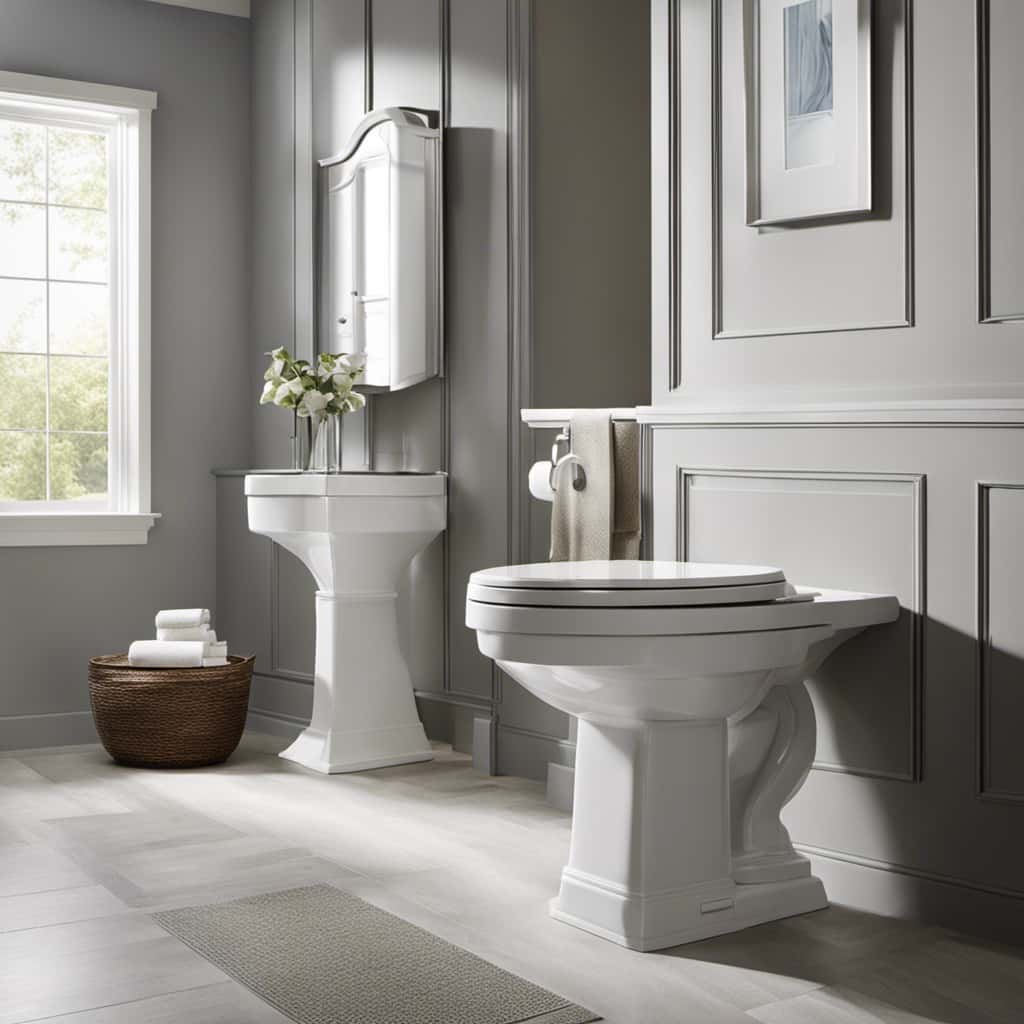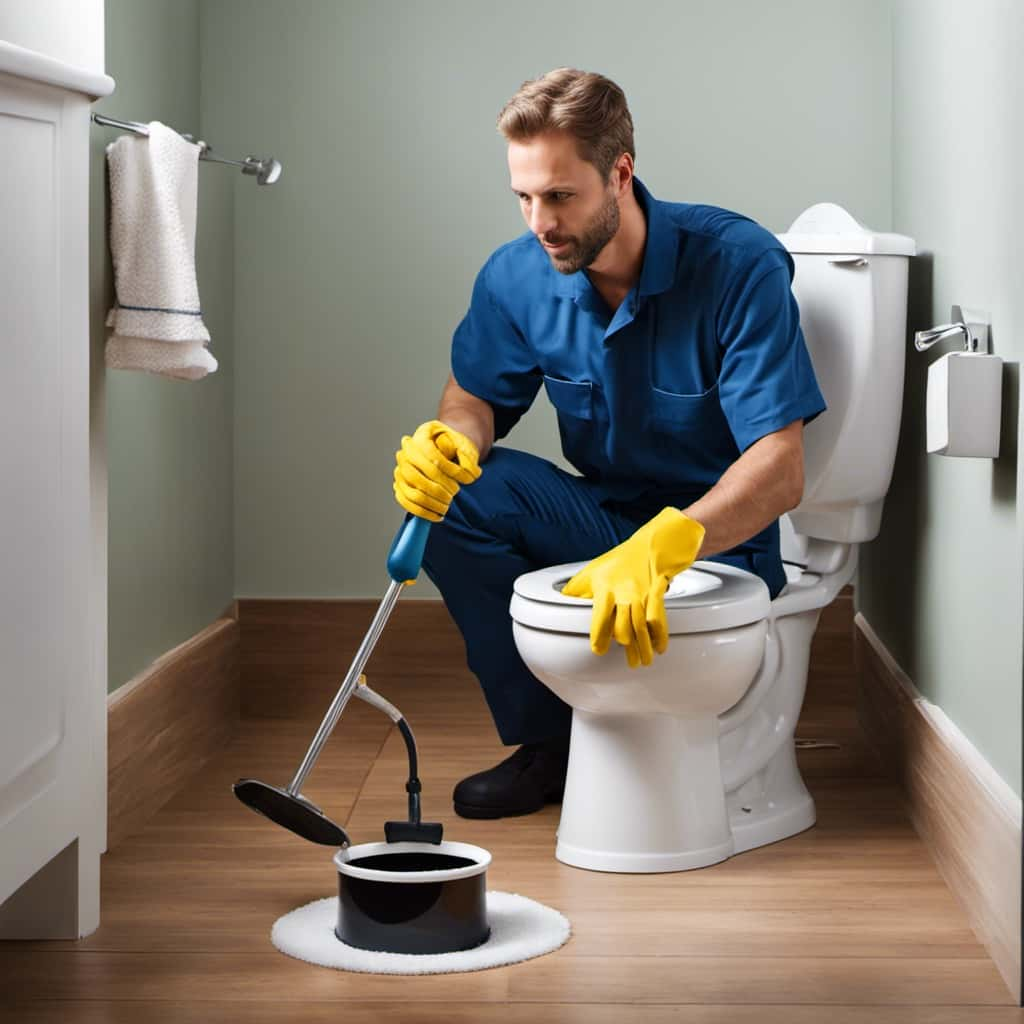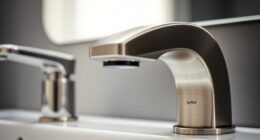We’ve all experienced using a flush toilet with a tank, but have you ever stopped to think about its actual mechanics?
Well, here’s an interesting statistic for you: did you know that the average person flushes a toilet about 2,500 times a year?
In this article, we’ll dive into the inner workings of a tank flush toilet, exploring the connection between the tank and bowl, the water supply mechanism, and the flushing power and efficiency.
Get ready to master the art of toilet technology!

Key Takeaways
- The tank and bowl connection is sealed with a rubber gasket and secured with bolts and nuts to prevent leaks and water wastage. Regular cleaning of the tank and bowl helps maintain hygiene and eliminates odors.
- The water supply mechanism consists of a water supply line, fill valve, and flush valve. The water supply line provides pressure for a strong flush, the fill valve controls water flow during the refill cycle, and the flush valve releases water from the tank to the bowl during a flush. The water level can be adjusted for optimal flushing power, and the water released during a flush helps clean the bowl.
- The flushing mechanism is operated by a flush lever that lifts the flapper or valve at the bottom of the tank. This allows water to be released into the bowl, creating a siphon effect that rapidly empties the bowl and carries waste away. The flushing mechanism ensures an efficient and effective flush, maintaining a clean and sanitary environment.
- The float valve is responsible for controlling the water level inside the tank. It maintains the water level at the desired level by regulating water flow to prevent overflow or insufficient filling. The float, attached to the valve, detects water level changes and shuts off the water supply when the desired level is reached. Proper water level control is crucial for efficient flushing, and the float valve plays a key role in achieving this.
Tank and Bowl Connection
To connect the tank and bowl of a flush toilet, a rubber gasket is placed between them using a series of bolts and nuts. This connection is crucial for the proper functioning of the toilet and ensuring its efficiency. The rubber gasket acts as a seal, preventing any leaks or water wastage. It also helps maintain the cleanliness of both the tank and bowl.
Regular tank cleaning is essential to remove any debris or sediment that may accumulate over time, ensuring the smooth flow of water during each flush. Additionally, maintaining bowl hygiene is vital for a sanitary and pleasant experience. Cleaning the bowl regularly with appropriate cleaning agents helps eliminate germs and odors, promoting a hygienic environment in the bathroom.
Water Supply Mechanism
Now, let’s delve into the water supply mechanism, a crucial aspect of the tank flush toilet’s functionality and efficiency. The water supply pressure plays a significant role in ensuring a powerful and effective flush.
Here are five key points to understand about the water supply mechanism:

- Water supply pressure: The water supply line provides the necessary pressure to fill the tank and create a strong flushing force. Higher water supply pressure can result in a more forceful flush.
- Fill valve: The fill valve controls the flow of water into the tank during the refill cycle. It opens when the tank is empty and closes when the water level reaches the desired level.
- Flush valve: The flush valve is responsible for releasing the water from the tank into the toilet bowl during the flush. It opens when the flush lever is activated and closes once the tank is empty.
- Water level adjustment: The water level in the tank can be adjusted to ensure optimal flushing power and efficiency. It’s typically controlled by a float mechanism or an adjustable valve.
- Toilet bowl cleaning: The water supply mechanism also plays a role in cleaning the toilet bowl. The water released during the flush helps to remove waste and keep the bowl clean.
Understanding the water supply mechanism is essential for maintaining a properly functioning and efficient tank flush toilet. By ensuring adequate water supply pressure and proper adjustment of the water level, you can optimize the flushing power and keep the toilet bowl clean.
Flushing Mechanism
Moving on to the flushing mechanism, let’s explore how the water supply mechanism discussed earlier interacts with the toilet’s internal components to initiate a powerful and efficient flush.
The flushing mechanism is responsible for releasing a large volume of water into the bowl, effectively removing waste and cleaning the surface. When the user activates the flush lever, it lifts the flapper or valve located at the bottom of the tank. This action releases the water stored in the tank, creating a forceful flow into the bowl.
The water release process is carefully designed to create a siphon effect, which rapidly empties the bowl and carries waste away. This mechanism ensures that the toilet flushes efficiently and effectively, maintaining a clean and sanitary environment.

Float Valve Operation
The float valve plays a crucial role in the operation of a tank flush toilet. It’s responsible for controlling the water level inside the tank.
Float Valve Function
How exactly does the float valve function in the operation of a tank flush toilet?
The float valve plays a crucial role in regulating the water level inside the toilet tank. When the tank is emptied after a flush, the float valve allows water to enter the tank until a certain level is reached.
Here are five key functions of the float valve:

- Maintains water level: The float valve ensures that the water level inside the tank stays at the desired level.
- Controls water flow: It regulates the flow of water into the tank, preventing overflow or insufficient filling.
- Detects water level: The float attached to the valve rises or falls based on the water level, signaling the valve to open or close accordingly.
- Shuts off water: When the tank reaches the desired water level, the float valve shuts off the water supply to prevent overfilling.
- Troubleshooting: If the toilet is constantly running or the water level is too low, float valve maintenance may be required to fix any issues.
Understanding the function of the float valve is essential for proper maintenance and troubleshooting of a tank flush toilet.
Water Level Control
To continue our discussion on the operation of a tank flush toilet, let’s explore the water level control and how it’s managed through the operation of the float valve.
Water level regulation is crucial for the proper functioning of a toilet, as it ensures efficient flushing control. The float valve, also known as the fill valve or ballcock, is responsible for controlling the water level in the tank.
When the tank is empty, the float valve is in an open position, allowing water to flow in. As the water level rises, the float attached to the valve also rises. Once the desired water level is reached, the float valve closes, stopping the flow of water. This mechanism ensures that the tank is always filled to the appropriate level for effective flushing.

Now, let’s move on to the next section to understand the functionality of the flapper valve.
Flapper Valve Functionality
The flapper valve is a crucial component in the functionality of a tank flush toilet. It acts as a barrier between the tank and the bowl, preventing water from continuously flowing into the bowl.
When the toilet is flushed, the flapper valve lifts, allowing water to quickly enter the bowl and create a powerful flush.
The efficiency of the flapper valve, including its seal and responsiveness, plays a significant role in the overall effectiveness of the flushing process.

Flapper Valve Mechanism
We operate the flapper valve mechanism by manually lifting the handle. The flapper valve is a crucial component of a tank flush toilet, responsible for controlling the flow of water from the tank into the bowl. Understanding how the flapper valve works is essential for proper maintenance and replacement.
Here are five key points to consider:
- The flapper valve seals the flush valve opening when the toilet isn’t in use, preventing water from continuously flowing into the bowl.
- Over time, the flapper valve may deteriorate or become damaged, leading to leaks or incomplete flushes.
- Regular flapper valve maintenance, such as cleaning and checking for proper alignment, can help prolong its lifespan and ensure optimal performance.
- If the flapper valve is beyond repair, a flapper valve replacement is necessary. This involves removing the old flapper valve and installing a new one.
- Proper installation and adjustment of the flapper valve are crucial to prevent water waste and maintain efficient flushing.
Understanding the intricacies of the flapper valve mechanism is essential before delving into the water release process.
Water Release Process
Our tank flush toilet initiates the water release process through the functionality of the flapper valve. When the toilet is flushed, the handle is pressed down, lifting the flapper valve attached to the flush valve located at the bottom of the tank.

This action creates an opening that allows water to flow from the tank into the bowl. The flapper valve acts as a seal, preventing water from continuously flowing into the bowl.
As the water enters the bowl, it creates a siphon effect that pulls waste and wastewater from the bowl through the trapway and into the sewer line.
Once the tank is empty, the flapper valve drops back into place, sealing off the tank and allowing it to refill for the next flush.
This water release process ensures efficient and effective flushing of the toilet.

Flushing Efficiency Factors
One key factor that affects the flushing efficiency of a tank flush toilet is the functionality of the flapper valve. The flapper valve is responsible for controlling the flow of water from the tank into the bowl during a flush. Its proper functioning is crucial for a powerful and effective flush.
Here are five factors related to the functionality of the flapper valve that affect flushing efficiency:
- Flapper seal: A tight seal between the flapper and the flush valve is essential to prevent any leakage and ensure maximum water pressure.
- Flapper size: The size of the flapper affects the amount of water released during a flush. A larger flapper allows for a more powerful flush.
- Flapper material: The material used for the flapper valve affects its durability and longevity. A high-quality, durable material is recommended for optimal performance.
- Flapper chain length: The length of the chain connected to the flapper determines how quickly it closes after the flush. Proper adjustment ensures efficient water release.
- Flapper maintenance: Regular inspection and cleaning of the flapper valve is necessary to prevent any buildup or damage that could hinder its functionality.
Gravity-Assisted Flushing
To understand how a tank flush toilet works, let’s dive into the mechanics of gravity-assisted flushing.
Gravity-assisted flushing is a common flushing mechanism used in toilets that relies on the force of gravity to remove waste from the bowl. When the handle is pressed, a valve in the tank opens, allowing water to flow into the bowl. The weight of the water creates a downward force, which creates water pressure and initiates the flushing process.

As the water rushes into the bowl, it displaces the air in the trapway, creating a siphon effect. This siphon effect pulls the waste and water from the bowl, through the trapway, and into the sewage system.
The key to a successful gravity-assisted flush is ensuring that there’s enough water pressure and volume to create a strong siphon and effectively remove waste from the bowl.
Siphon Jet Action
Siphon jet action in a tank flush toilet is a water propulsion mechanism that ensures efficient waste removal and prevents clogging issues.
This mechanism involves a powerful jet of water that creates a siphoning effect, rapidly removing waste from the bowl.

As the toilet flushes, the siphon jet action provides a forceful push, effectively clearing the bowl and maintaining a clean and hygienic environment.
Water Propulsion Mechanism
When we flush a tank flush toilet, the water propulsion mechanism, known as siphon jet action, is responsible for creating a powerful force that efficiently removes waste from the bowl. This mechanism is based on the principle of water pressure control and is designed to ensure thorough toilet bowl cleaning.
Here are five key aspects of the water propulsion mechanism:
- Siphon Jet: The siphon jet is a small opening located at the bottom of the toilet bowl. When the toilet is flushed, water rushes through this opening, creating a strong jet of water.
- Forceful Water Flow: The siphon jet action propels a high-velocity stream of water into the bowl, which helps to dislodge waste and carry it away.
- Vortex Effect: The jet of water creates a swirling vortex in the bowl, enhancing the cleaning action by agitating the water and waste.
- Effective Waste Removal: As the water rushes out of the bowl, it creates a vacuum effect that efficiently removes waste from the bowl and into the drain pipe.
- Optimized Design: The shape and size of the siphon jet opening, as well as the angle at which the water is directed, are carefully engineered to maximize the cleaning power and minimize water usage.
Understanding the water propulsion mechanism of a tank flush toilet allows for a mastery of its functionality and efficiency in waste removal.

Efficient Waste Removal
As we delve further into the workings of a tank flush toilet, let’s explore the efficiency of waste removal through the powerful siphon jet action. This mechanism ensures effective waste disposal while maintaining water efficiency.
When the toilet is flushed, water is released from the tank and flows into the bowl, creating a strong force that propels the waste through the trapway and into the sewage system. The siphon jet action plays a crucial role in this process by generating a powerful suction that draws the waste downward.
This efficient waste removal system minimizes the risk of clogs and ensures that waste is effectively transported away from the toilet. By optimizing water usage and maximizing waste disposal efficiency, tank flush toilets provide a reliable and sustainable solution for maintaining a clean and sanitary bathroom environment.
Prevents Clogging Issues
Our powerful siphon jet action prevents clogging issues by efficiently removing waste from the toilet. This innovative design ensures that blockages are minimized, providing a hassle-free experience for users.

To maintain the optimal functionality of the toilet and prevent any potential blockages, here are some maintenance tips:
- Regular cleaning: Clean the toilet bowl and jet holes frequently to remove any build-up that can lead to clogging.
- Proper flushing technique: Encourage users to flush only toilet paper and waste that can be easily broken down, avoiding the disposal of items that can cause blockages.
- Water pressure check: Ensure that the water pressure is adequate for the siphon jet action to function effectively.
- Professional inspection: Periodically have a professional plumber inspect the toilet system to identify and address any potential issues before they become major problems.
- Educate users: Provide clear instructions to users on proper toilet usage, emphasizing the importance of preventing blockages by flushing responsibly.
Water Level Adjustment
To adjust the water level in a tank flush toilet, we simply turn the water level adjustment screw. This screw is typically located on top of the fill valve. By turning it clockwise, we lower the water level, and by turning it counterclockwise, we raise it.
The water level adjustment is crucial for maintaining the proper functioning of the toilet. It ensures that the tank fills with the correct amount of water, allowing for an effective flush. Additionally, it plays a role in water pressure regulation, as a higher water level can result in increased pressure during the flush.
Refilling the Tank
After adjusting the water level, we initiate the process of refilling the tank. This step is crucial for maintaining the functionality of the toilet and ensuring proper flushing. Here are some important considerations for water tank maintenance and troubleshooting common issues:

- Check the water supply: Ensure that the water supply valve is fully open and there are no obstructions or leaks in the supply line.
- Inspect the fill valve: Examine the fill valve for any signs of damage or wear, such as cracks or leaks. Replace it if necessary.
- Clean the tank: Regularly clean the tank to prevent mineral buildup or sediment accumulation, which can affect the refill process.
- Adjust refill rate: If the tank takes too long to refill or overflows, adjust the refill rate by turning the adjustment screw on the fill valve.
- Test the flush: After refilling the tank, test the flush to ensure that it’s working properly and the water level remains consistent.
Overflow Prevention
To prevent overflow, we must address potential issues that may cause the tank flush toilet to exceed its capacity. One key aspect of overflow prevention is water pressure control.
The water pressure in the tank needs to be properly regulated to ensure that it doesn’t exceed the maximum capacity of the toilet. This can be achieved through the use of a fill valve or float valve, which controls the flow of water into the tank. These valves are designed to maintain a specific water level in the tank, preventing it from overflowing.
Additionally, regular maintenance and inspection of the toilet’s components, such as the flapper valve and flush valve, are crucial in preventing overflow. By keeping these components in good working condition and addressing any issues promptly, the risk of overflow can be significantly reduced.
Flush Handle or Button
We operate the tank flush toilet by using a handle or button. The flush handle or button mechanism is an essential part of the toilet’s functionality.

Here are some key points to consider about the flush handle or button:
- Flush handle: It’s a lever usually located on the side of the toilet tank, which, when pressed, activates the flushing mechanism.
- Button mechanism: Some modern toilets have buttons instead of handles. These buttons are designed to provide a more ergonomic and user-friendly experience.
- Ergonomic design: The flush handle or button is carefully designed to ensure easy operation and comfortable use for users of all ages and abilities.
- Touchless operation: In recent years, touchless flush mechanisms have gained popularity. These mechanisms use sensors to detect the user’s presence and automatically initiate the flushing process.
- Hygiene considerations: Touchless flush mechanisms help maintain a high level of hygiene by reducing the need for direct contact with the flush handle or button.
Understanding the flush handle or button’s role in toilet operation is crucial to grasp the overall flushing power and efficiency.
Flushing Power and Efficiency
To achieve optimal flushing power and efficiency, we rely on the forceful expulsion of water from the toilet tank. Flushing power analysis is crucial in assessing the effectiveness of a toilet’s flush. By measuring the velocity and volume of water expelled during a flush, we can determine the flushing power of a toilet. Water saving techniques have revolutionized the industry, allowing toilets to maintain high flushing power while using less water. One such technique is the use of dual flush systems, which provide different flush options depending on the waste volume. Another technique is the incorporation of pressure-assisted systems, which use compressed air or water to enhance the flushing force. These advancements not only ensure efficient waste removal but also contribute to water conservation efforts.
| Flushing Power Analysis | Water Saving Techniques |
|---|---|
| Velocity measurement | Dual flush systems |
| Volume measurement | Pressure-assisted systems |
How Water Pressure Affects Flushing
As we delve into the topic of how water pressure affects flushing, let’s continue our exploration of the factors that contribute to optimal flushing power and efficiency.

Water pressure regulation plays a crucial role in determining the effectiveness of a tank flush toilet. Here are some key points to consider regarding the impact of water pressure:
- Water pressure directly affects the force with which water is expelled from the tank into the bowl.
- Insufficient water pressure can result in weak and incomplete flushes, leading to clogs and buildup.
- Excessive water pressure can cause splashing, noise, and unnecessary water wastage.
- Proper water pressure regulation ensures a balanced and efficient flushing process.
- Modern tank flush toilets are designed to maintain consistent water pressure, providing reliable performance.
Understanding the importance of water pressure in flushing allows us to appreciate the advancements in toilet technology, such as dual flush toilets, which we’ll explore in the subsequent section.
Dual Flush Toilets
One of the most efficient options for water conservation in toilet technology is the use of dual flush toilets. Dual flush technology allows users to choose between a full flush and a half flush, depending on the waste being disposed of. This feature helps to reduce water usage significantly, as the half flush option uses less water for liquid waste, while the full flush option is used for solid waste.
Maintenance and Troubleshooting Tips
When it comes to maintaining and troubleshooting a tank flush toilet, it’s important to regularly check for any leaks or issues with the flushing mechanism. Here are some maintenance tips and troubleshooting techniques to keep your tank flush toilet in optimal condition:

- Inspect the flush valve regularly to ensure it’s sealing properly.
- Clean the toilet tank regularly to prevent mineral buildup and clogs.
- Check the water level in the tank and adjust the float if necessary.
- Test the flush handle and chain to ensure they’re functioning smoothly.
- If you notice any leaks, replace the faulty seals or gaskets promptly.
Frequently Asked Questions
How Does a Tank Flush Toilet Compare to a Dual Flush Toilet in Terms of Water Efficiency?
A dual flush toilet, compared to a tank flush toilet, offers greater water efficiency due to its water saving features. The benefits of dual flush toilets include reduced water usage and the ability to choose between a low or high volume flush.
What Are Some Common Maintenance Tasks for a Tank Flush Toilet?
What are some common maintenance tasks for a tank flush toilet? We should regularly check the flapper, fill valve, and flush handle for any issues. Troubleshooting tips include adjusting the water level and cleaning the jets.
How Can I Troubleshoot a Tank Flush Toilet That Is Not Flushing Properly?
To troubleshoot a tank flush toilet that is not flushing properly, we can try a few troubleshooting tips. First, check the water level in the tank and adjust if needed. Additionally, ensure the flush valve and flapper are functioning correctly.
Can I Adjust the Water Level in the Tank to Increase or Decrease the Flushing Power?
Yes, we can adjust the water level in the tank to impact the flushing power. By increasing the water level, the flush will be more powerful, while decreasing it will result in a weaker flush.

How Does Water Pressure Affect the Flushing Performance of a Tank Flush Toilet?
Water pressure directly impacts the performance of a tank flush toilet. Higher water pressure increases the force with which the water is flushed, resulting in better toilet performance. Conversely, lower water pressure may lead to inadequate flushing.
Conclusion
In conclusion, the tank flush toilet operates through a combination of mechanisms including the connection between the tank and bowl, the water supply mechanism, and the flushing mechanism. The float valve controls the water level in the tank, while the flapper valve releases water into the bowl during flushing.
Water pressure plays a significant role in the flushing power and efficiency of the toilet. Understanding these mechanisms is crucial for proper maintenance and troubleshooting.
But have you ever wondered, what advancements will be made in toilet technology in the future?











